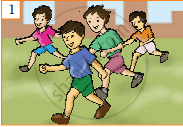Advertisements
Advertisements
प्रश्न
Find out stories about other great people’s lives and their childhood and write these in your notebook. Collect at least two such stories and share them with your friends.
You could think of famous
- scientists
- religious people
- freedom fighters
- brave children
- astronauts
- artists
उत्तर
Do it yourself.
APPEARS IN
संबंधित प्रश्न
Greenland is the largest island in the world.
(Rewrite: Using ‘larger’.)
Whose dirty looks are referred to?
This is the place. The dog was rescued from its cruel owner.
He is old but still he works hard. (Begin: Despite……….)
Your uncle has promised to give you a gift of Rs. 1000/-. Write a letter thanking him for the offer, tell him how you plan to spend the money; and why you wish to spend it in this way.
Which courtesies did Braithwaite ask his class to observe and how did the students react to these ‘new rules’? Describe the incident that brought about a change in Denham’s hostile attitude towards Braithwaite
Narrate an incident from your own experience when you helped a friend who was in trouble. Explain what happened. What did you do to make the situation better ?
He drew a beautiful diagram________ the board.
The following are the meaning listed in the dictionary against the phrase `take on’. In which meaning is it used in the third paragraph of the account:
|
Take on sth: |
to begin to have a particular quality or appearance; to assume sth |
|
take sb on: |
to employ sb; to engage sb |
|
Take sb/sth on: |
to decide to do sth; to allow sth/sb to enter e.g. a bus, plane or ship; to take sth/sb on board |
Do you think it is important to preserve languages?
Write a summary of the poem.
- Title
- Introductory paragraph (about the poem/ type/nature/tone)
- Main body (central idea/gist of the poem)
- Conclusion/ opinions/views/appeal.
Understand the quotation and expand it in a paragraph format.
'Pride goes on horseback, but returns on foot'.
Work in pairs. Create three slogans on ‘Saving Trees’.
Read this example Save a Tree Get Oxygen for Free.
- Use catchy, meaningful phrases.
- Do not write complete sentences.
- Ensure that the words at the end rhyme.
Answer the question by looking at the picture.
Example: What is happening in picture 5?

Write rhyming words for the words given below. One has been done for you.
- morning - evening
- car
- high
- boots
- heat
- where
The word in the sentence is jumbled. Write them in order.
alone was not Robinson an island on
Why are photographs taken?
| e.g. to freeze our favourite moments | |
What was the only similarity between Leacock’s face and his photograph?
Why was Miss Meadows upset and dejected?
Summarizing is to briefly sum up the various points from the notes made from the below passage.
The Sherpas were nomadic people who first migrated from Tibet approximately 600 years ago, through the Nangpa La pass and settled in the Solukhumbu District, Nepal. These nomadic people then gradually moved westward along salt trade routes. During 14th century, Sherpa ancestors migrated from Kham. The group of people from the Kham region, east of Tibet, was called “Shyar Khamba”. The inhabitants of Shyar Khamba, were called Sherpa. Sherpa migrants travelled through Ü and Tsang, before crossing the Himalayas. According to Sherpa oral history, four groups migrated out of Solukhumbu at different times, giving rise to the four fundamental Sherpa clans: Minyagpa, Thimmi, Sertawa and Chawa. These four groups have since split into the more than 20 different clans that exist today.
Sherpas had little contact with the world beyond the mountains and they spoke their own language. AngDawa, a 76-year-old former mountaineer recalled “My first expedition was to Makalu [the world’s fifth highest mountain] with Sir Edmund Hillary’’. We were not allowed to go to the top. We wore leather boots that got really heavy when wet, and we only got a little salary, but we danced the Sherpa dance, and we were able to buy firewood and make campfires, and we spent a lot of the time dancing and singing and drinking. Today Sherpas get good pay and good equipment, but they don’t have good entertainment. My one regret is that I never got to the top of Everest. I got to the South Summit, but I never got a chance to go for the top.
The transformation began when the Sherpa Tenzing Norgay and the New Zealander Edmund Hillary scaled Everest in 1953. Edmund Hillary took efforts to build schools and health clinics to raise the living standards of the Sherpas. Thus life in Khumbu improved due to the efforts taken by Edmund Hillary and hence he was known as ‘Sherpa King’.
Sherpas working on the Everest generally tend to perish one by one, casualties of crevasse falls, avalanches, and altitude sickness. Some have simply disappeared on the mountain, never to be seen again. Apart from the bad seasons in 1922, 1970 and 2014 they do not die en masse. Sherpas carry the heaviest loads and pay the highest prices on the world’s tallest mountain. In some ways, Sherpas have benefited from the commercialization of the Everest more than any group, earning income from thousands of climbers and trekkers drawn to the mountain. While interest in climbing Everest grew gradually over the decades after the first ascent, it wasn’t until the 1990s that the economic motives of commercial guiding on Everest began. This leads to eclipse the amateur impetus of traditional mountaineering. Climbers looked after each other for the love of adventure and “the brotherhood of the rope” now are tending to mountain businesses. Sherpas have taken up jobs as guides to look after clients for a salary. Commercial guiding agencies promised any reasonably fit person a shot at Everest.
